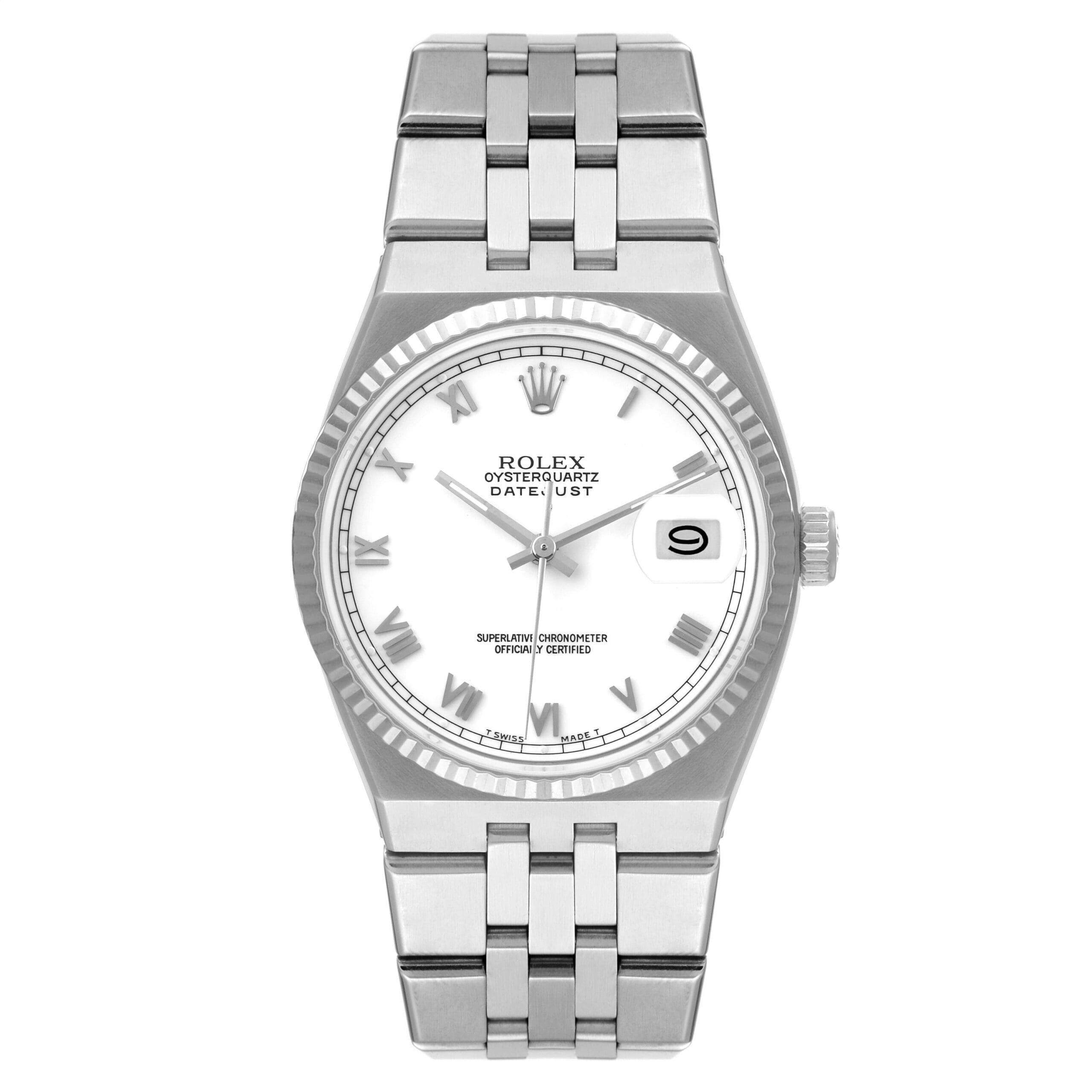Don't miss the next drop
Rolex Oysterquartz Datejust 17014
Last updated: July 22, 2025

Brand:
Model Line:
Production Period:
1977-2001
Caliber/s:
Case Width:
36mm
Case Height:
42mm
Lug Width:
20mm
Rolex Oysterquartz Datejust 17014 Description
The Rolex Oysterquartz Datejust ref. 17014 was introduced in 1977 and remained in production until 2001, with some remaining available until about 2003. It featured a 36 mm stainless-steel case paired with an 18k white-gold fluted bezel and fitted with Rolex’s acclaimed in-house Caliber 5035 thermocompensated quartz movement. Equipped with an integrated steel Jubilee bracelet and sapphire crystal with Cyclops, the 17014 combined Rolex’s precision engineering with distinctive angular 1970s styling. Today, it is prized for its rarity, robust design, and modern-heritage aesthetic.
Technical Specifications
| Reference | 17014 |
| Production Period | 1977–2001 (last available by 2003) |
| Case Diameter | 36 mm |
| Lug‑to‑Lug | ~42.5 mm |
| Case Thickness | ~12.5 mm |
| Lug Width | ~20 mm (integrated Jubilee) |
| Movement | Caliber 5035 quartz, 32 kHz, 11 jewels |
| Accuracy | Chronometer-grade (COSC certified from ~1980s onwards) |
| Power Reserve | Approx. 24 months battery life |
| Case Material | Stainless steel with 18k white-gold bezel |
| Crystal | Sapphire with date-magnifier |
| Water Resistance | 100 m standard Oyster case |
| Dial Options | Multiple, including baton indices and Roman numerals |
Detailed Overview
Development of the Oysterquartz movement began in 1972, culminating in its debut in 1977. The Datejust 17014 was powered by Rolex’s in-house Caliber 5035, featuring a stepping motor at 32 kHz and thermocompensation for improved accuracy over standard quartz movements. COSC certification was granted to later generations of the 5035, which modified the oscillator design around the early 1980s.
The 17014 adopted a strongly angular “tonneau” case design with an integrated Jubilee bracelet—selected for its comfort and aesthetic continuity. The combination of brushed and polished finishing accentuated its modern 1970s character. Its steel case is topped by a fluted white-gold bezel, distinguishing it from the smoother steel-bezel ref. 17000 and the steel/yellow-gold 17013.
Dial configurations are diverse, with baton and Roman indices on silver, black, or blue backgrounds. Custom or rare dials, such as purple or “Buckley” Roman variants, add to its collectible appeal .
Variations and Context
The Oysterquartz Datejust lineup comprised just three 5-digit references: ref. 17000 (steel, polished bezel), ref. 17013 (steel/gold, yellow-gold bezel), and ref. 17014 (steel, white-gold bezel). All shared the Caliber 5035 quartz engine and 36 mm angular case design. The 17014’s distinguishing features—a white‑gold fluted bezel and steel Jubilee—make it unique and slightly more exclusive than the base 17000.
Market Position as of Mid‑2025
Secondary-market listings for the 17014 typically range from $6,000 to $15,000, with full-set, well-preserved examples commanding the upper end near $15,000 . More affordable units appear around $6,000–$8,000, though collector interest in integrated-quartz models has been gradually raising prices . As of mid‑2025, the 17014 remains undervalued compared to mechanical equivalents but is trending upward and gaining wider appreciation.
Conclusion
The Rolex Oysterquartz Datejust ref. 17014 offers a compelling mix of quartz precision, integrated-era design, and elegant white‑gold styling. Its rarity and distinctive design language place it firmly in the spotlight of modern-heritage collecting. With its COSC‑grade movement, sapphire crystal, and refined aesthetics, it represents one of Rolex’s most intriguing quartz masterpieces—poised for both appreciation and continued relevance among discerning collectors.
As an eBay Partner, we may be compensated if you make a purchase.
